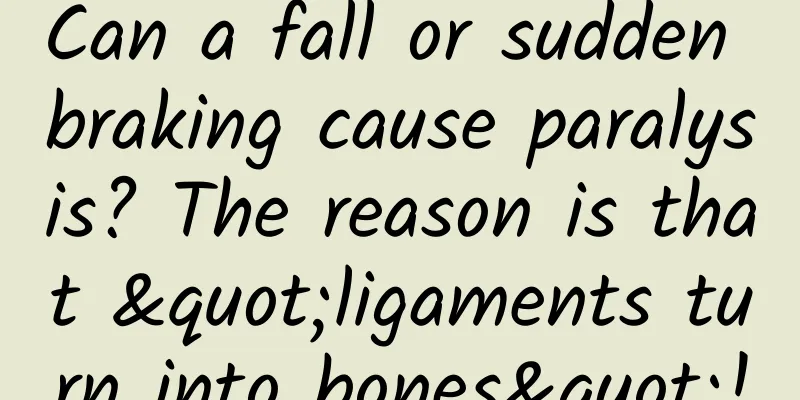Can a fall or sudden braking cause paralysis? The reason is that "ligaments turn into bones"!

|
This is the 3574th article of Da Yi Xiao Hu Ms. Xu, 65 years old, retired I often have neck pain, and last year I started to feel numbness in my hands. Sometimes I feel dizzy and weak when walking, as if I am walking on cotton. Two days ago, Ms. Xu accidentally slipped and fell to the ground while cleaning the house. I immediately felt a loss of sensation in my limbs, my hands and feet were out of control, and I couldn't move. The family called "120" and rushed Ms. Xu to the emergency department of Zhongshan Hospital affiliated to Fudan University. After an emergency and detailed examination by the orthopedics department, it was found that half of the vertebral canal in Ms. Xu's neck that contained the spinal cord was occupied by "bone" that should not have been there. The resulting compression of the cervical spinal cord caused complete paralysis of her limbs. So the question is, why do bones grow where there shouldn't be bones? It turns out that this disease is ossification of the posterior longitudinal ligament of the cervical spine, which means "ligament turns into bone" in layman's terms. The posterior longitudinal ligament of the cervical spine is a long ligament of the spine, located behind the vertebral body and intervertebral disc in the spinal canal. It is narrow and tough. It can limit the excessive forward bending of the spine and prevent the intervertebral disc from protruding backwards. Under normal circumstances, the posterior longitudinal ligament is very thin and will not affect the spinal cord. However, when the posterior longitudinal ligament ossifies and becomes "bone", it will block the spinal canal and compress the spinal cord and nerve roots in the spinal canal, causing symptoms of spinal cord damage, such as paresthesias in the hands, feet and trunk, movement disorders and other neurological symptoms. We call this disease ossification of the posterior longitudinal ligament of the cervical spine. The ossified posterior longitudinal ligament of the cervical spine can significantly narrow the spinal canal, and even a slight trauma can cause or aggravate the original spinal cord injury, and in severe cases, cause quadriplegia of the patient. After Ms. Xu was hospitalized, the team led by Professor Dong Jian, director of the Department of Orthopedics at Zhongshan Hospital, carefully developed a treatment plan for her. Through surgery, the volume of the spinal canal was expanded and the compression on the spinal cord was relieved. After the surgery, her limb sensory and motor disorders improved. She is currently continuing medication, hyperbaric oxygen therapy and rehabilitation exercises. Why do bones grow where they shouldn’t grow? The cause of ossification of the posterior longitudinal ligament of the cervical spine is still unclear. The possible factors include chronic strain, trauma, diet, abnormal sugar and calcium metabolism, genetics, etc. In addition to ossification of the posterior longitudinal ligament of the cervical spine, some patients may also have ossification of the nuchal ligament and the yellow ligament of the thoracic spine, and have a tendency to ossify multiple parts of the spine. What are the clinical manifestations of ossification of the posterior longitudinal ligament of the cervical spine? Ossification of the posterior longitudinal ligament of the cervical spine is a slow process. In the early stage, there may be no symptoms, or only pain in the neck accompanied by stiffness and soreness. Therefore, most patients are middle-aged and elderly people. When the ossification of the posterior longitudinal ligament increases to a certain extent and blocks the spinal canal, causing cervical spinal stenosis, numbness and weakness of the upper limbs, inflexible hand movements, unstable gait of the lower limbs, and a feeling of floating when walking, as if walking on cotton. It is worth noting that the symptoms of ossification of the posterior longitudinal ligament of the cervical spine are similar to those of cervical spondylosis that we often hear about, but the causes of the two are different. Cervical spondylosis is caused by aging and degeneration of the cervical intervertebral disc, which affects the surrounding structures, causing intervertebral disc herniation, bone hyperplasia, etc., compressing the spinal cord and nerve roots, thus causing symptoms similar to ossification of the posterior longitudinal ligament of the cervical spine. Key Points Because the disease is hidden and often occurs unconsciously, the early symptoms are not obvious and easy to ignore. However, if there is trauma or an accident, such as a fall, sudden braking, etc., the symptoms may suddenly worsen, and even lead to paralysis due to an accidental fall, as happened to Ms. Xu in this article. If the above symptoms occur, others should not move the patient at will. Call an ambulance in time to send the patient to the orthopedic or spinal surgery department of a regular hospital for treatment! Once diagnosed, how is it treated? For patients with early stage and mild symptoms, conservative treatment such as medication is feasible, similar to the conservative treatment of cervical spondylosis, but traction and massage should be used with caution or contraindicated. For patients with obvious symptoms, surgery is required to relieve spinal cord compression. Kind tips How to prevent neck injuries Place frequently used items at home in easy-to-reach places to avoid climbing high places Keep the floor dry and free of water Wear non-slip slippers at home Lay anti-slip mats and install handrails in bathrooms and toilets Avoid sudden braking when riding in a car and be careful when going up and down stairs Author: Liang Haifeng and Li Juan Instructor: Dong Jian Unit: Department of Orthopedics, Zhongshan Hospital Affiliated to Fudan University Institute of Medical Science Popularization, Fudan University This article was funded by the following project: Shanghai Science and Technology Commission Science Popularization Project (No.: 20DZ2312000, 21DZ2302900) Shanghai Municipal Health Commission Outstanding Academic Leader Project (No.: GWV-10.2-XD11) Some pictures are taken from the Internet. If there is any infringement, please let us know and they will be deleted. All names and place names are pseudonyms and any similarity is purely coincidental. |
<<: It can quench your thirst, but you can't eat too much. Here's how to eat pears healthily
>>: How to choose edamame? What is the nutritional value of edamame?
Recommend
Want to eat all the crayfish? First figure out: where are you eating crayfish from?
Recently, although the temperature has repeatedly...
39 weeks pregnant abdominal distension
It is quite common to have abdominal distension d...
Can I get pregnant again after having a miscarriage?
Miscarriage is a terrifying experience for any wo...
Can I eat oats during my period?
Menstruation for women is a very normal thing. It...
Causes of lumps under women's armpits
Most people don't know why they have lumps un...
Extreme high temperatures lead to frequent heat stroke incidents. How can we prevent heat stroke in this hot summer?
As the 2024 college entrance examination comes to...
Are your eyes thirsty? Add some color to your vision
Author: Huang Zhuanqing, 944th Hospital of the Jo...
This wild vegetable is rich in dietary fiber and has lower calories than apples! If you miss it, you will have to wait another year!
There are many wild vegetables in spring. Those g...
Pregnancy and constant urge to defecate
During pregnancy, because women are carrying a ch...
Can I eat Eucommia during menstruation?
We all know that due to the special physiological...
Why can't you eat pig blood during menstruation?
Women's menstruation comes every year, but so...
What changes will occur in the body of people who eat kidneys frequently?
Chinese people are very fond of various animal of...
Characteristics of fetal blood circulation
Key reminder: The characteristic of the fetal blo...
Will eating red beans during breastfeeding reduce milk production?
Red beans have the effect of nourishing blood and...
How should women take care of themselves after hysterectomy?
The body will have different symptoms at differen...









